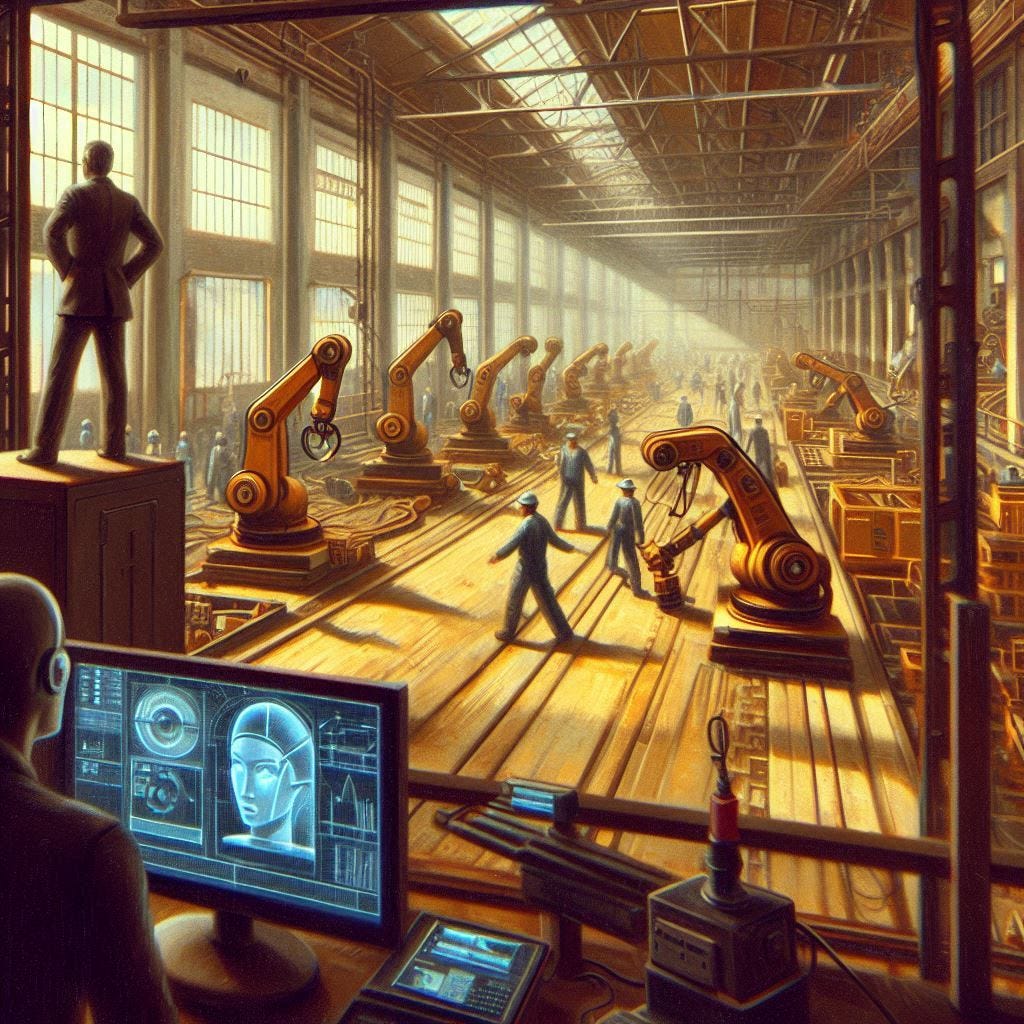Weekly Roundup: Laboring Under AI
How AI and robotics are reshaping the workforce, plus innovative legal reform driving capital.
The disruption emerging technology brings to the labor force is rarely predictable. Many inventions during both Industrial Revolutions actually created a greater need for labor. One of the most infamous second-order effects of innovation was the cotton gin driving demand for slavery in early 19th century America.
Combining AI and robotics may create jobs that the market can’t anticipate. However, it seems the immediate effect will be to replace low-skill labor.
Humanoid Robots Finally Get Real Jobs
In a large, brightly lit warehouse in Flowery Branch, Ga., a pair of human-shaped robots made by Agility Robotics tiptoe across polished concrete floors, their gait oddly mincing. Their legs end in narrow, hoof-like feet sheathed in custom nonslip shoes. They stoop to retrieve bins full of Spanx shapewear, then carry them to a nearby conveyor belt.
The robots described above are designed to directly replace humans. A somewhat different example can be seen in “Robot City.”
The small Danish city of Odense has become known for collaborative robots.
The success of these two large robotics companies, which together employ around 800 people in Odense, created a ripple effect, bringing both funding and business acumen into the robotics cluster, says Søren Elmer Kristensen, CEO of the government-funded organization Odense Robotics.
There are challenges to being based in a city that, though the third-largest in Denmark, is undeniably small on the global scale. Attracting funding is one issue. Most investment still comes from within the country’s borders. Sourcing talent is another; demand outstrips supply for highly qualified tech workers. Kasper Hallenborg, director of the [Mærsk Mc-Kinney Møller Institute (MMMI), a center dedicated to studying autonomous systems], says the institute feels an obligation to produce enough graduates to support the local industry’s needs…As the Odense robotics cluster expands, however, it has become easier to attract international talent. It’s less of a risk for people to move, because plenty of companies are hiring if one job doesn’t work out.
For the majority of the still-employed-humans, the immediate impact is AI workforce monitoring. Increasing worker efficiency while keeping labor costs low has long been an essential part of the fundamental capitalist equation, but now nearly every company has intrusive AI tools to help them.
Your boss is watching
A study conducted in 2021, when the covid-19 pandemic had greatly increased the number of people working from home, revealed that almost 80% of companies surveyed were monitoring their remote or hybrid workers. A New York Times investigation in 2022 found that eight of the 10 largest private companies in the US track individual worker productivity metrics, many in real time. Specialized software can now measure and log workers’ online activities, physical location, and even behaviors like which keys they tap and what tone they use in their written communications—and many workers aren’t even aware that this is happening.
A Y Combinator backed startup that provides workforce monitoring showed a dystopic version of the Elf scene, where Buddy doesn’t meet his quota:
“Ugh, it’s workspace 17. Workspace 17 is the bottleneck. The worst performing workspace here,” one of the bosses says, while watching a video of a man making clothing in a factory. “Hey number 17, what’s going on man? You are in red,” he says. “I have been working all day,” the person playing the worker says. “Working all day?” the line boss replies. “You haven’t hit your hourly output even once today. And you have 11.4% efficiency, this is really bad!”
“It’s just been a rough day,” the “worker” replies. “Rough day?” the boss says, looking at a calendar full of red days. “More like a rough month.”
While the labor market has been relatively stable in a large portion of the world, there is no reason to assume it will stay that way. Remote work was supposed to be a boon to international workers and rural communities in the US. With AI being able to conduct tasks that used to take years of university-level education, like the ability to program, that boon seems like it is in the rearview mirror. For a rundown on the tech letdown in African countries, check out this week’s Tech Safari.
Security
An excellent analysis of the history of sanctions and the future of economic warfare, read (or listen) to the piece published by ChinaTalk this Week:
Microsoft urges Donald Trump to rethink AI chip export controls. “Company president Brad Smith warns the new rules will force American allies to buy Chinese products.”
The Rise of the Fake Tech Workforce: State-Sponsored Infiltration of U.S. Technical Supply Chains. This fantastic article written by Nathaniel Davis and Nina Kollars (I had the pleasure of meeting Nina at a U.S. Naval War College event last year) examines how state-sponsored actors are infiltrating U.S. technical supply chains by creating fake tech workers, leveraging remote work and contract employment to bypass security checks. It offers some “low hanging fruit” as solutions that could have outsized impacts on this problem.
Innovating the law
Texas Is the Low-Cost, High-Reward Darling of Big Tech
There are many benefits to moving your company to Texas and a few pitfalls, but it would be short-sighted to dismiss the business-friendly draw entirely to warm weather and conservative politics. They are doing some innovative legal reform that other states should look to copy.
Texas is trying to leverage a new tool to get yet more companies to establish at least a foothold there: its own specialized business court. The court started work last year hearing complex commercial litigation, with judges appointed by Gov. Greg Abbott to two-year terms. Texas is among the states that launched such courts to try to attract companies and challenge the decadeslong dominance of Delaware’s business courts.
China wants tech companies to monetize data, but few are buying in:
The government has allowed all Chinese companies to register data as assets on their balance sheets.
Adoption of the policy has been slow, with only a small percentage of companies logging data as assets.
Compliance hurdles are high, but China’s experiment could potentially shape global accounting norms.
All 50 States Have Now Introduced Right to Repair Legislation
So far, right to repair laws have been passed in Massachusetts, New York, Minnesota, Colorado, California, and Oregon. Another 20 states are formally considering right to repair bills during this current legislative session. The rest have previously introduced bills that have not passed; so far we have seen that many states take several years to move a given right to repair bill through the legislative process.
In other news
White House Correspondents’ Association cedes control of pool reports to Trump administration. Even in the ubiquitous world of social media, access to the government can be effectively controlled. Control over the press pool means access will be limited to friendly social media platforms (X and Truth Social) and friendly traditional media outlets. Relatedly (I guess), Bluesky Deletes AI Protest Video of Trump Sucking Musk's Toes, Calls It 'Non-Consensual Explicit Material'
Nigerians are building affordable alternatives to AWS and Google Cloud. “Local cloud startups offer data sovereignty at a time when the debate about who has access to a country’s data is heating up.”
‘Moon Dust on Our Boots’: Texas Company’s Blue Ghost Lands on Lunar Surface. “Firefly Aerospace’s robotic vehicle became the second privately built spacecraft to make a soft landing on the moon. It could soon be joined by two more private lunar landers.”




